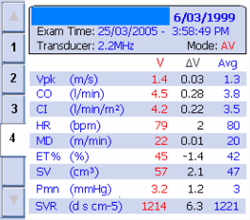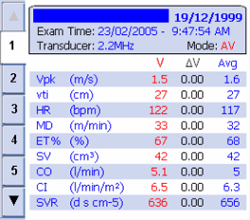USCOM in Paediatrics.
Can the USCOM be used in children? The answer is an emphatic “yes!” and very much more easily than in adults in the main. Kids are very amenable to “would you like to listen to your heart with my special computer”. Provided they’re not too ill, they will usually help you press the buttons, and they love hearing the whoosh-whoosh of their cardiac output. Because of their smaller size, the aortic and pulmonary valves are much nearer to the insonation site and are therefore much easier to pick up. The shorter distance also results in less signal attenuation and better quality traces in less time than in adults.
A word of warning however; children are not small adults. At times I think they are actually a different species! Whilst the basic rules of hemodynamics apply in paediatrics, some of the haemodynamic values might surprise you. Take a look at these data screens. The screen on the left is from a child of just over 6 years who weighed 20kg. The screen on the right is from a 5 year old who weighed 17.5kg. What do you see?
 
The numbers are certainly interesting, but I expect that there a few things you need to know before you can draw any definite conclusions. The clinical history is obviously important, as are other observations like BP, temperature, skin colour and so on. But more than all this, I bet you said to yourself “what’s the normal value for that in a child of 5/6?”. Now there’s a whole new ball-game to explore! Hemodynamics is just as applicable in children, but because children are so different in so many crucial ways, they will get a booklet all to themselves. Watch out for part three of the USCOM trilogy “USCOM – Hemodynamics in Children”.
|

